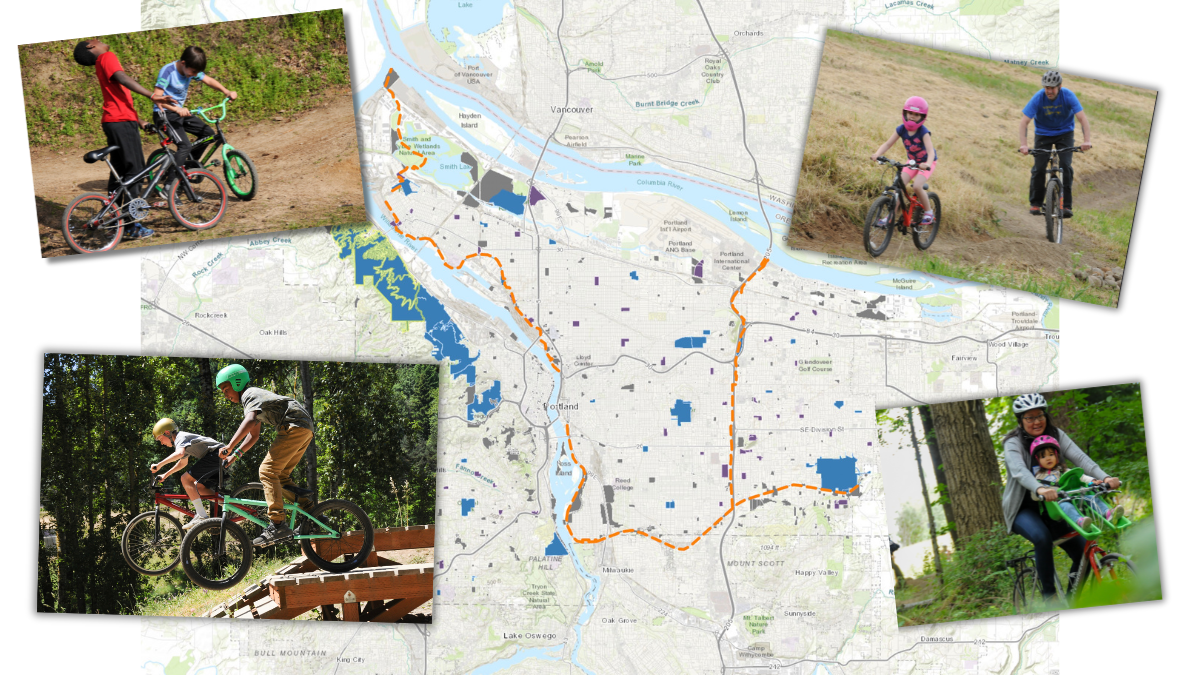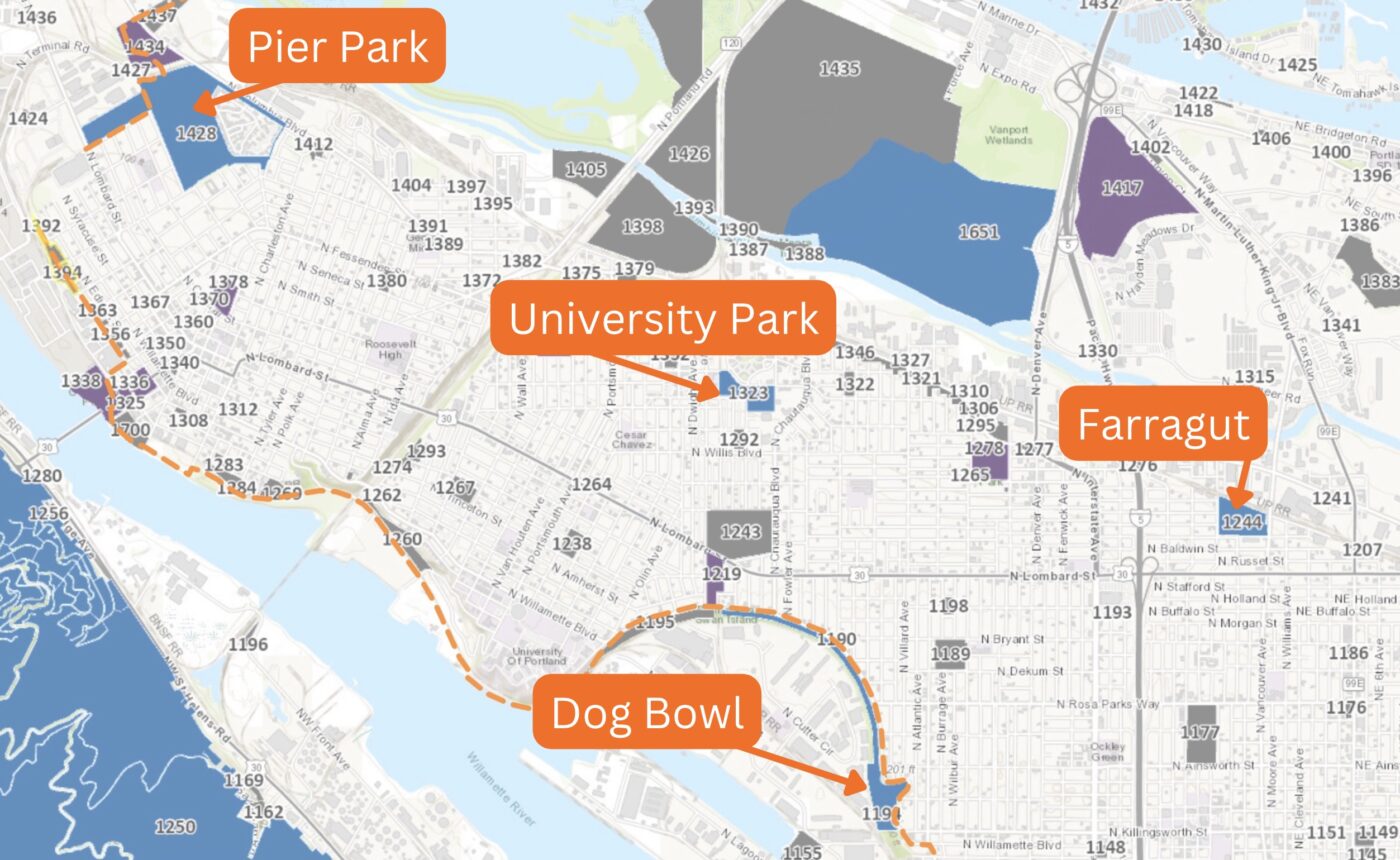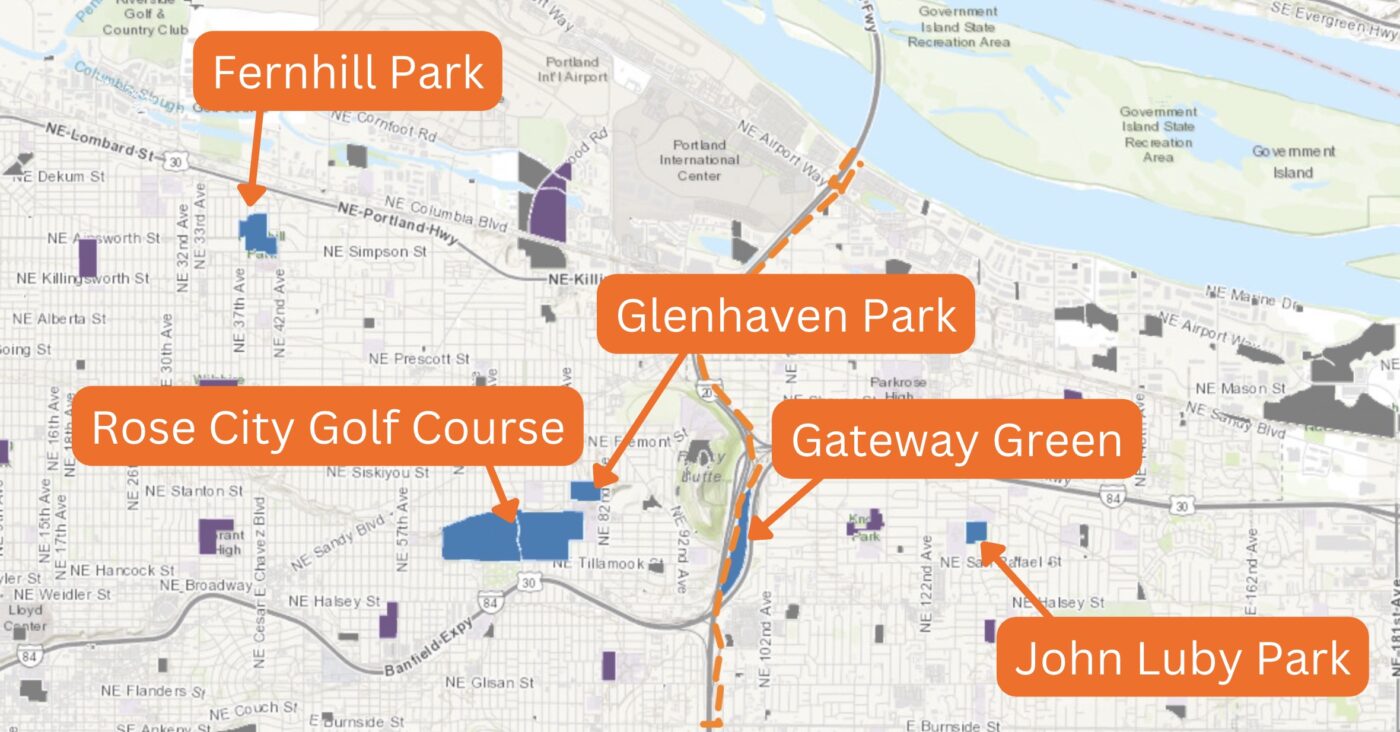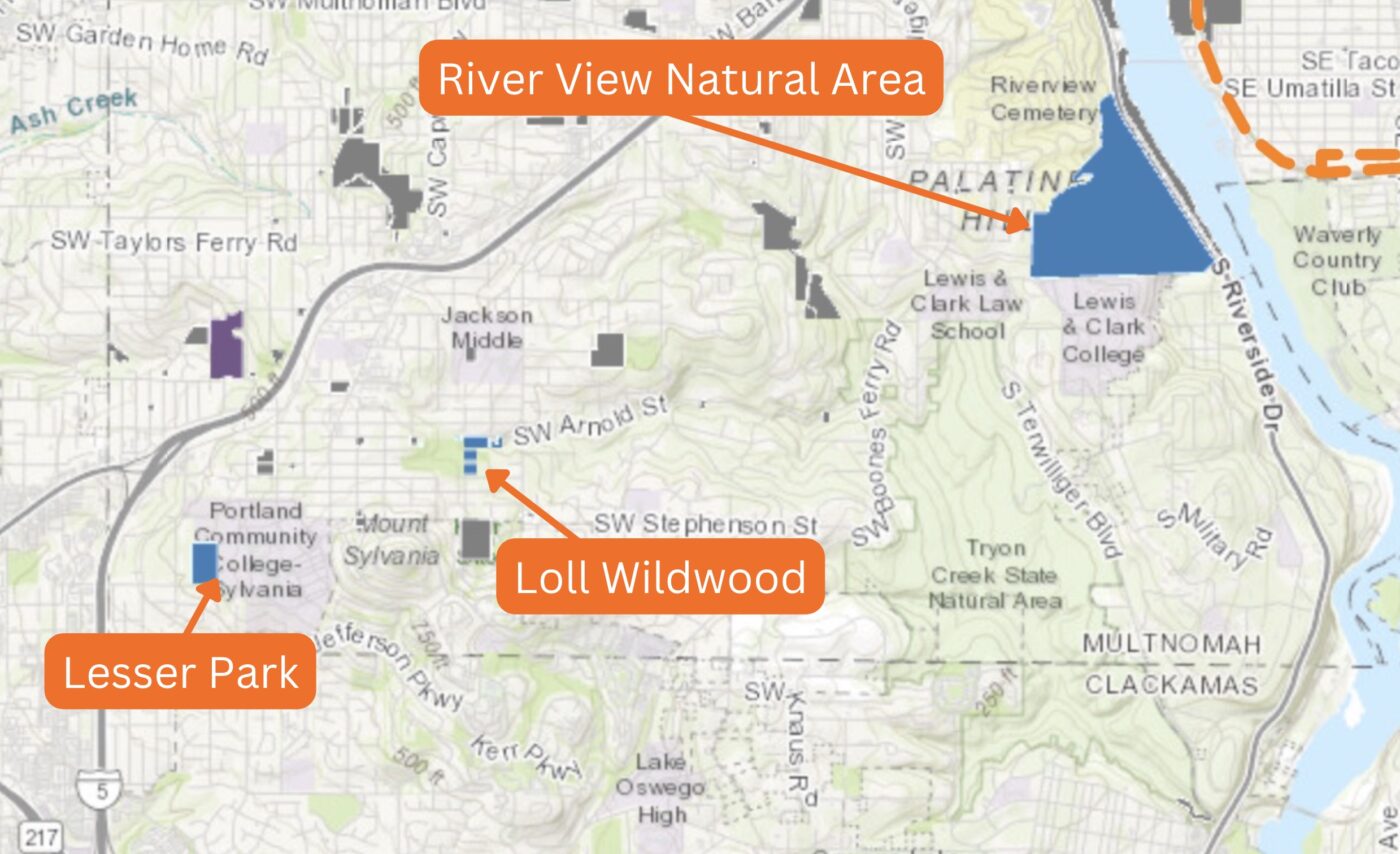
(Map: Bureau of Planning & Sustainability. Photos: Jonathan Maus/BikePortland)
There are 154 parks in Portland with about 12,000 acres of land. About one-forth of those acres have something built on them (think golf course, playgrounds, racetrack at PIR, and so on) and the rest (about 70% of the total acreage) is just grass and trees and dirt. According to the newly adopted Off Road Cycling Master Plan, 23 of those parks could easily handle new bike trails or some sort of pump/skills track.
For years now, some folks have felt like we could build more off-road trails in these parks in order to open up more cycling opportunities for Portlanders. Right now there’s a shocking lack of places in this city where you can hop on a bicycle and experience the mental and physical pleasures of navigating a dirt trail. The people who love doing that are mostly forced to hop in their cars and head to riding areas near Mt. Hood, Sandy, Hood River, or (relatively recently) Scappoose. For everyone else, off-road cycling has just never been an option.
Yes, we have dirt to ride in Forest Park, but it’s either extremely boring (flat, wide roads) or extremely difficult for all but expert riders.
The solution, some people say, is to use what we have and build new trails and riding areas inside the existing parks that are within an easy bicycling distance of almost every Portlander. We’ve already had some success with this: the Gateway Green bike park and the small pump tracks at Ventura Park (also east Portland) and in New Columbia neighborhood in St. Johns. On any given day when the sun is out and dirt is dry, you can find all types of smiling people — especially younger ones — riding bikes in these parks.
Why do we have so few places like this? Part of the reason is politics and what I’ve described as Portland’s irrational fear of off-road cycling. But it’s also just due to a lack of planning and advocacy. Before anything happens around here, we need some sort of plan. Then we need people who care about it to stand up and push for it. When it comes to off-road cycling in parks, we now have both parts of that equation primed and ready-to-go.
Now that the Off Road Cycling Master Plan is an official city plan, it’s time to recognize that its authors have singled out 23 existing city parks — in every corner of our city — they think are compatible with unpaved bike riding areas. The list below comes from a map included in the plan where BPS labels parks and other parcels that are ripe for new trails and/or bike parks. Check it out, and get those gears turning for more places to safely ride our bikes without having to drive a car to a trailhead!
North
Pier Park – 85 acres
- A Master Plan, developed with community involvement, to guide future improvements to the park
- A medium-sized bicycle park (about 1 acre). Bicycle parks have areas for family recreation and skill building. The bicycle park could be located near the popular skate park.
- A natural surface loop trail for family-friendly cycling, walking, running and enjoyment of nature. Off-road cycling skill features (like rocks, logs, or skinny bridges) could be added along the sides. Care should be taken to limit potential conflicts with disc golf course.
University Park – 11 acres
- A small bicycle park (about 5,000 to 10,000 ft²). Bicycle parks have areas for family recreation and skill building. The bicycle park would be located outside the sports fields.
- A natural surface loop trail for family-friendly cycling, walking and running. Off-road cycling skill features (like rocks, logs, or skinny bridges) could be added along the sides.
- Building a bicycle park or trail here will require additional planning and community input
Dog Bowl – 25 acres
- Habitat restoration including native plantings and removal of invasive plants
- Closure and restoration of existing demand trails.
- A natural surface trail network for family-friendly cycling, walking, running and enjoyment of nature. This trail network should connect should remain on the upper, flatter portion of the site and protect oak habitat
- Building a trail here will require additional planning and community input
- Transfer of property to Portland Parks & Recreation
Farragut Park – 14 acres
- A small bicycle park (about 5,000 to 10,000 sf). Bicycle parks have areas for family recreation and skill building
- A natural surface loop trail for family-friendly cycling, walking and running
- Building a bicycle park or trail here will require additional planning and community input
Northeast
Fernhill Park – 27 acres
- A natural surface loop trail for family-friendly cycling, walking, running and enjoyment of nature. Off-road cycling skill features (like rocks, logs, or skinny bridges) could be added along the sides. A well-designed loop of approximately 1.5 miles could also provide a better trail for the cross-country running races and training held at the park. Care should be taken to limit potential conflicts with off-leash dog area.
- A medium-sized bicycle park (about 1 acre). Bicycle parks have areas for family recreation and skill building
- A Master Plan, developed with community involvement, to guide future improvements to the park. This Master Plan could also consider an east-west paved and lighted trail to improve park access and connections.
- Building a bicycle park or trail here will require additional planning and community input, including from neighbors, running groups, off leash dog area users, and other park users.
Glenhaven Park – 14 acres
- A natural surface loop trail for family-friendly cycling, walking, running and enjoyment of nature. Off-road cycling skill features (like rocks, logs, or skinny bridges) could be added along the sides. The loop trail could connect to the proposed trail at Rose City Golf Course and connect to neighborhoods south of NE Tillamook Street.
- A small bicycle park (about 5,000 to 10,000 ft²). Bicycle parks have areas for family recreation and skill building.
- Building a bicycle park or trail here will require additional planning and community input.
Rose City Golf Course – 151 acres
- A natural surface loop trail for family-friendly cycling, walking, running and enjoyment of nature. Off-road cycling skill features (like rocks, logs, or skinny bridges) could be added along the sides. The loop trail could provide safe walking access along NE Tillamook and connect neighborhoods to the south of the golf course to Glenhaven Park. Creating a full loop may require on-street segments. Care should be taken to limit potential conflicts with the golf course.
- A small bicycle park (about 5,000 to 10,000 ft²). Bicycle parks have areas for family recreation and skill building.
- Building a bicycle park or trail here will require coordination with the Rose City Golf Course and additional planning and community input.
John Luby Park – 10 acres
- A natural surface loop trail for family-friendly cycling, walking, running and enjoyment of nature. Off-road cycling skill features (like rocks, logs, or skinny bridges) could be added along the sides. The loop trail could provide safe walking access along NE Tillamook and connect neighborhoods to the south of the golf course to Glenhaven Park. Creating a full loop may require on-street segments. Care should be taken to limit potential conflicts with the golf course.
- A small bicycle park (about 5,000 to 10,000 ft²). Bicycle parks have areas for family recreation and skill building.
- Building a bicycle park or trail here will require coordination with the Rose City Golf Course and additional planning and community input.
Southeast
Colonel Summers Park – 6 acres
- A small bicycle park (about 5,000 – 10,000 ft²). Bicycle parks have areas for family recreation and skill building
- Building a bicycle park here will require additional planning and community input
Mt Tabor Park – 183 acres
- Habitat restoration including native plantings and removal of invasive plants
- Closure and restoration of demand trails.
- Trail network improvements to make it more sustainable, reduce redundant trail segments, and create a loop for off-road cycling
- Improved signage to help park users navigate and understand whether trails are open to pedestrians, cyclists, or both
Creston Park – 14 acres
- A small bicycle park (about 5,000 – 10,000 ft²). Bicycle parks have areas for family recreation and skill building. The bicycle park could replace the closed tennis courts.
- A natural surface loop trail for family-friendly cycling, walking, running and enjoyment of nature
- Building a bicycle park or trail here will require additional planning and community input
Brentwood Park – 13 acres
- A small bicycle park (about 5,000 – 10,000 ft²). Bicycle parks have areas for family recreation and skill building
- Building a bicycle park here will require additional planning and community input
Gates Park – 11 acres
- A Master Plan, developed with community involvement, to guide future improvements to the park
- A large bicycle park (1 to 3 acres). Bicycle parks have areas for family recreation and skill building
- A natural surface loop trail (about ½ mile) for family-friendly cycling, walking and running. Off-road cycling skill features (like rocks, logs, or skinny bridges) could be added along the sides.
Lynchview Park – 8 acres
- A small bicycle park (about 5,000 to 10,000 ft²). Bicycle parks have areas for family recreation and skill building
- A natural surface loop trail for family-friendly cycling, walking and running. Off-road cycling skill features (like rocks, logs, or skinny bridges) could be added along the sides.
- Possible partnership with the adjacent elementary school
- Building a bicycle park or trail here will require additional planning and community input
- This location is an alternate to Parklane Park
Ventura Park – 7 acres
Ventura Park has two pump tracks — one for intermediate riders and a second for young children.
- Continuing to improve drainage at the pump track
- Improving and possibly expanding the pump tracks
- A natural surface loop trail for family-friendly cycling, walking and running. Off-road cycling skill features (like rocks, logs, or skinny bridges) could be added along the sides.
South
River View Natural Area – 146 acres
- Stream and habitat restoration including native plantings and removal of invasive plants
- Continued the interim prohibition of off-road cycling until sustainable trails are identified or developed
- Complete detailed alignment planning and trail design for the natural surface trail loop described in the River View Natural Area Management Plan’s Access and Management Concept as a model of a sustainable and safe shared-use trail.
- Design trails using best management practices appropriate to the natural area’s topography, environmental assets, and expected level of use by pedestrians and cyclists. See pages 76 – 77 of the Discussion Draft for additional design guidance.
- If the City cannot identify a sustainable shared-use trail alignment that is consistent with best management practices while meeting site objectives, evaluate alternative approaches and management strategies.
- Fund and build a well-designed, sustainable trail that will limit potential negative impacts, reduce maintenance costs, and serve recreational users. Ongoing investment in trail maintenance will also be required.
- Consider opportunities to build other recommended natural surface trails in western Portland either before, or in concert with, River View trail design and construction to help distribute the latent demand for off-road cycling experiences.
- Develop a maintenance plan for the trail system that identifies unacceptable environmental impacts or safety risks and methods to address these impacts.
- Monitor trail use, including any safety or environmental risks, through on-site observation and/or community reporting.
- Use adaptive management strategies (e.g. seasonal closures, trail improvements, education, conditional or permanent rerouting or closure of trails, use restrictions) to address unsustainable conditions or unacceptable impacts.
- Building a trail here will require additional planning and community input
Loll Wildwood – 2 acres
- A Management Plan for the entire natural area, developed with community involvement, to guide environmental restoration, stewardship, and recreational access
- Stream and habitat restoration including native plantings and removal of invasive plants
- Closure and restoration of existing demand trails
- Natural surface trails for family-friendly cycling, walking, running and enjoyment of nature. Trails could include and east-west trail on the north side of the creek, a single bridge crossing, and a loop trail on the south side of the creek. The trails would provide a way to experience the natural area and make it easier to walk and bike to destinations in the neighborhood.
- Building a trail here will require additional planning and community input
Lesser Park – 8 acres
- Habitat restoration including native plantings and removal of invasive plants
- Closure and restoration of existing demand trails
- A natural surface trail network for family-friendly cycling, walking, running and enjoyment of nature. This trail network should connect to natural trails at the Portland Community College – Sylvania Campus.
- Building a trail here will require additional planning and community input
Southwest
Gabriel Park – 90 acres
- A Master Plan, developed with community involvement, to guide future improvements to the park
- Continued natural area enhancements. Gabriel Park’s natural areas have undergone significant environmental restoration and pedestrian trail improvements
- A medium-sized bicycle park (about 10,000 ft² to ½ acre). Bicycle parks have areas for family recreation and skill building. The bicycle park could be located near the popular skate park and away from natural areas.
- A shared-use natural surface loop trail (about 1.5 to 3 miles), outside of the core natural area. This trail could be used by nearby residents for family-friendly cycling, walking, running and enjoyment of nature. Off-road cycling skill features (like rocks, logs, or skinny bridges) could be added along the sides.
- A designated safe pedestrian and cyclist route along SW 45th Avenue, including crossings
- Improved signage to help park users navigate and understand whether trails are open to pedestrians, cyclists, or both
Hamilton Park – 10 acres
- A small bicycle park (about 5,000 to 10,000 ft²). Bicycle parks have areas for family recreation and skill building
- A natural surface loop trail for family-friendly cycling, walking, running and enjoyment of nature
- Building a bicycle park or trail here will require additional planning and community input
Washington Park – 292 acres
- Restoration of degraded wildlife habitat through native plantings and removal of invasive plants
- Closure and restoration of existing demand trails
- A natural surface off-road cycling trail loop in the area east of Kingston Drive, as envisioned in the Draft Washington Park Master Plan. Trails could include a descending flow trail and an uphill skill trail.
- Building a trail here will require additional planning and community input
Forest Park (Southern Section) – 1178 acres
- Continue to implement the Forest Park Natural Resource Management Plan and other adopted plans and strategies for the park
- Expand and enhance a comprehensive education and outreach program regarding trail rules and etiquette
- Improve signage for wayfinding and trail use expectations
- Increase resources and partnerships for restoration, management, enforcement and trail maintenance
- Monitor impacts of trails and recreation use on vegetation, wildlife and users
- Practice adaptive management, including trail closures, to address unintended negative impacts. Decommission unsanctioned trails
- Improve Firelane 1 for better environmental sustainability and to make it a safer and more enjoyable route for cycling, walking, and running, while maintaining emergency access
- Build a new trail open to off-road cyclists parallel to St. Helen’s Road. This trail should connect Northwest Portland to the proposed Forest Park Nature Center and Firelane 1
- Build a new trail south of NW 53rd Drive (conditional on completion of Firelane 1 improvements, St. Helen’s trail, improvements to Holman Lane, and assessment of watershed impacts)
- See pages 61 – 72 of theDiscussion Draft for more information
Forest Park (Central Section) – 1945 acres
- Continue to implement the Forest Park Natural Resource Management Plan and other adopted plans and strategies for the park
- Expand and enhance a comprehensive education and outreach program regarding trail rules and etiquette
- Improve signage for wayfinding and trail use expectations
- Increase resources and partnerships for restoration, management, enforcement and trail maintenance
- Monitor impacts of trails and recreation use on vegetation, wildlife and users
- Practice adaptive management, including trail closures, to address unintended negative impacts. Decommission unsanctioned trails
- Improve Firelane 1 for better environmental sustainability and to make it a safer and more enjoyable route for cycling, walking, and running, while maintaining emergency access
- Build a new trail open to off-road cyclists parallel to St. Helen’s Road. This trail should connect Northwest Portland to the proposed Forest Park Nature Center and Firelane 1
- Build a new trail south of NW 53rd Drive (conditional on completion of Firelane 1 improvements, St. Helen’s trail, improvements to Holman Lane, and assessment of watershed impacts)
- See pages 61 – 72 of the Discussion Draft for more information
Check out the Off Road Cycling Plan website where you’ll find the map and lots of other helpful info.








